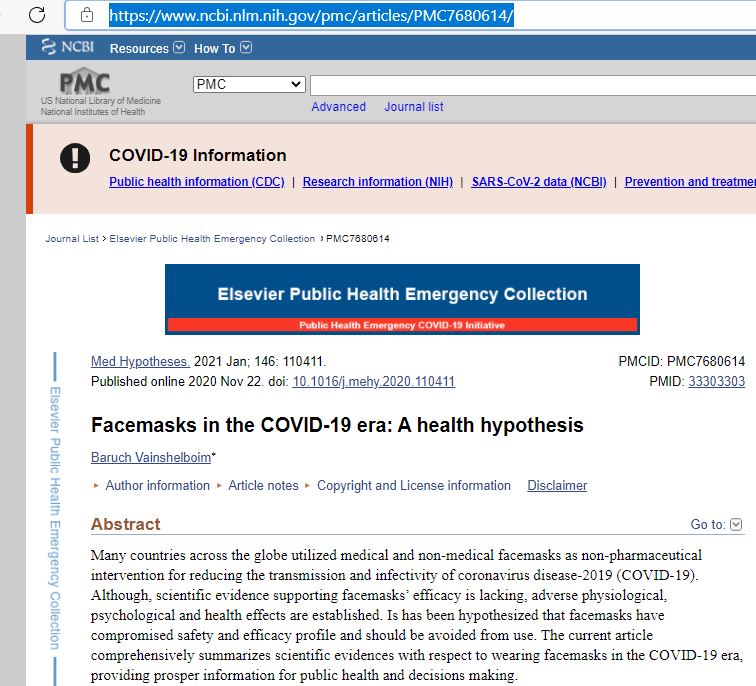NIH published a medical hypothesis by Dr. Baruch Vainshelboim that suggests that long-term wearing of facemasks “has strong potential for devastating health consequences.” Why?

April 26 Update: The claims made by Dr. Baruch Vainshelboim have been refuted by the Stanford School of Medicine. Please click on the link below to read a more accurate version of this article.
The debate about the effectiveness of facemasks has been raging on since they were introduced around April 2020 to stop the spread of coronavirus. Even Dr. Anthony Fauci, director of the National Institute of Allergy and Infectious Diseases (NIAID) at the National Institutes of Health (NIH), said on March 8, 2020, that “there’s no reason to be walking around with a mask.” Dr. Fauci has since changed his position on the use of masks and now in support of masks.
However, some states have lifted the mask mandates on their citizens. For example, the Lone Star State of Texas ignored Dr. Fauci’s advice. On March 10, Texas Governor Greg Abbott signed an executive order ending Texas’ statewide mask mandate and allow all businesses to operate at full capacity. To the surprise of many medical experts, including Dr. Fauci, COVID-19 cases continue to drop in the State of Texas since the executive order went into effect 5 weeks ago.
Now to add to the mask controversy, the National Institutes of Health (NIH) recently published a November 2020 medical hypothesis (not a study peer-reviewed by peers) that “suggest that facemasks are ineffective to block viral particles due to their difference in scales.” The piece was authored by Baruch Vainshelboim, who according to his LinkedIn profile works in a cardiology division of the U.S. Veterans Affairs Palo Alto Health Care System in California.
In the NIH article, Baruch also hypothesized that the “long-term practice of wearing facemasks has strong potential for devastating health consequences. Prolonged hypoxic-hypercapnic state compromises normal physiological and psychological balance, deteriorating health, and promotes the development and progression of existing chronic disease.” In the article, Dr. Baruch came up with the following four hypotheses:
“1) the practice of wearing facemasks has compromised safety and efficacy profile, 2) Both medical and non-medical facemasks are ineffective to reduce human-to-human transmission and infectivity of SARS-CoV-2 and COVID-19, 3) Wearing facemasks has adverse physiological and psychological effects, 4) Long-term consequences of wearing facemasks on health are detrimental.”
However, it didn’t take long before Politifact, a Left-leaning and fact-checking website, said the medical hypothesis article posted on the NIH website “lacks evidence that masks cause ill effects.” This leads to our original question: Why did NIH publish this medical hypothesis considering the criticism and controversy? So, instead of trying to answer the question or judging the merit of the article, we would like you to read the article and make your judgment call and form your own opinion.
Here is the introduction to the hypothesis
Facemasks are part of non-pharmaceutical interventions providing some breathing barrier to the mouth and nose that have been utilized for reducing the transmission of respiratory pathogens [1]. Facemasks can be medical and non-medical, where two types of the medical masks primarily used by healthcare workers [1], [2]. The first type is National Institute for Occupational Safety and Health (NIOSH)-certified N95 mask, a filtering face-piece respirator, and the second type is a surgical mask [1]. The designed and intended uses of N95 and surgical masks are different in the type of protection they potentially provide. The N95s are typically composed of electret filter media and seal tightly to the face of the wearer, whereas surgical masks are generally loose fitting and may or may not contain electret-filtering media. The N95s are designed to reduce the wearer’s inhalation exposure to infectious and harmful particles from the environment such as during extermination of insects. In contrast, surgical masks are designed to provide a barrier protection against splash, spittle and other body fluids to spray from the wearer (such as surgeon) to the sterile environment (patient during operation) for reducing the risk of contamination [1].
The third type of facemasks are the non-medical cloth or fabric masks. The non-medical facemasks are made from a variety of woven and non-woven materials such as Polypropylene, Cotton, Polyester, Cellulose, Gauze and Silk. Although non-medical cloth or fabric facemasks are neither a medical device nor personal protective equipment, some standards have been developed by the French Standardization Association (AFNOR Group) to define a minimum performance for filtration and breathability capacity [2]. The current article reviews the scientific evidences with respect to safety and efficacy of wearing facemasks, describing the physiological and psychological effects and the potential long-term consequences on health.
Hypothesis
On January 30, 2020, the World Health Organization (WHO) announced a global public health emergency of severe acute respiratory syndrome-coronavirus-2 (SARS-CoV-2) causing illness of coronavirus disease-2019 (COVID-19) [3]. As of October 1, 2020, worldwide 34,166,633 cases were reported and 1,018,876 have died with virus diagnosis. Interestingly, 99% of the detected cases with SARS-CoV-2 are asymptomatic or have mild condition, which contradicts with the virus name (severe acute respiratory syndrome-coronavirus-2) [4]. Although infection fatality rate (number of death cases divided by number of reported cases) initially seems quite high 0.029 (2.9%) [4], this overestimation related to limited number of COVID-19 tests performed which biases towards higher rates. Given the fact that asymptomatic or minimally symptomatic cases is several times higher than the number of reported cases, the case fatality rate is considerably less than 1% [5]. This was confirmed by the head of National Institute of Allergy and Infectious Diseases from US stating, “the overall clinical consequences of COVID-19 are similar to those of severe seasonal influenza” [5], having a case fatality rate of approximately 0.1% [5], [6], [7], [8]. In addition, data from hospitalized patients with COVID-19 and general public indicate that the majority of deaths were among older and chronically ill individuals, supporting the possibility that the virus may exacerbates existing conditions but rarely causes death by itself [9], [10]. SARS-CoV-2 primarily affects respiratory system and can cause complications such as acute respiratory distress syndrome (ARDS), respiratory failure and death [3], [9]. It is not clear however, what the scientific and clinical basis for wearing facemasks as protective strategy, given the fact that facemasks restrict breathing, causing hypoxemia and hypercapnia and increase the risk for respiratory complications, self-contamination and exacerbation of existing chronic conditions [2], [11], [12], [13], [14].
Of note, hyperoxia or oxygen supplementation (breathing air with high partial O2 pressures that above the sea levels) has been well established as therapeutic and curative practice for variety acute and chronic conditions including respiratory complications [11], [15]. It fact, the current standard of care practice for treating hospitalized patients with COVID-19 is breathing 100% oxygen [16], [17], [18]. Although several countries mandated wearing facemask in health care settings and public areas, scientific evidences are lacking supporting their efficacy for reducing morbidity or mortality associated with infectious or viral diseases [2], [14], [19]. Therefore, it has been hypothesized: 1) the practice of wearing facemasks has compromised safety and efficacy profile, 2) Both medical and non-medical facemasks are ineffective to reduce human-to-human transmission and infectivity of SARS-CoV-2 and COVID-19, 3) Wearing facemasks has adverse physiological and psychological effects, 4) Long-term consequences of wearing facemasks on health are detrimental.”
You can read the entire article on the NIH website.
April 22 Update: We’ve received several emails that the article was NOT published on the NIH (.Gov) website. To address any confusion, we have decided to add a screenshot from the NIH website below. You may also click on the screenshot below to go directly to the NIH website.





